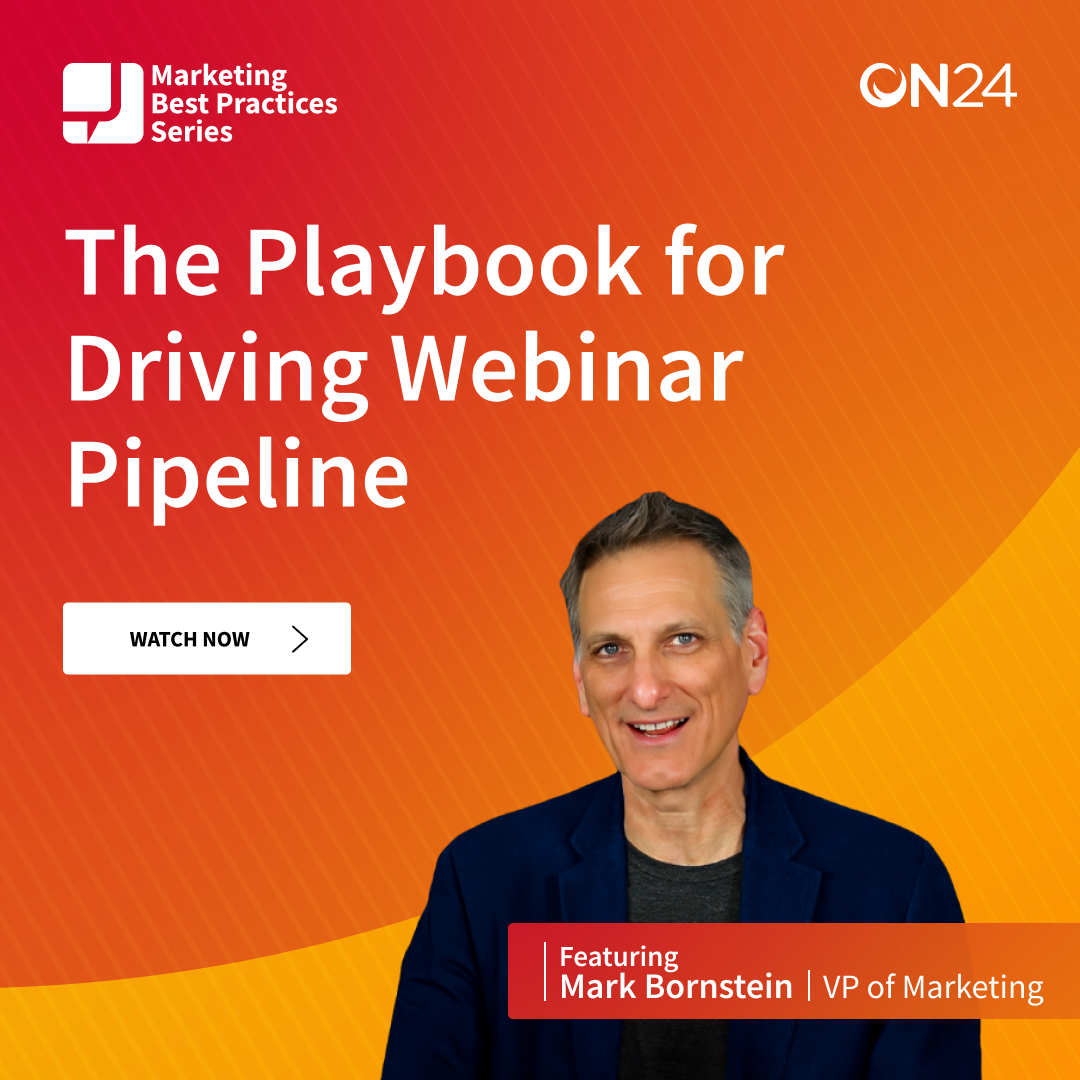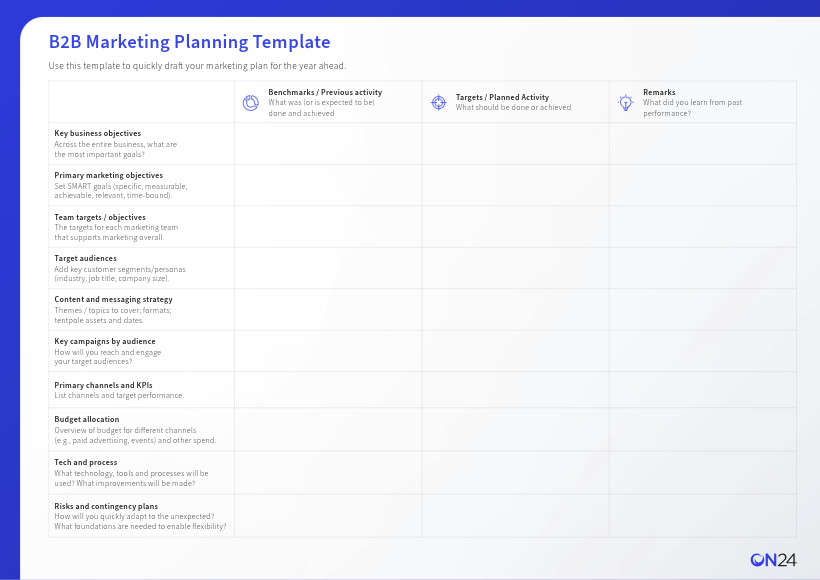B2B marketing planning can be a time-consuming and unfulfilling activity. This is especially true if B2B leaders feel that any carefully constructed plans will inevitably change — whether because of new targets being set, promised budgets being changed or any other curveball that might come their way.
As a response, the team at ON24 has just released a One-Page B2B Marketing Planning Template to enable B2B marketing leaders to quickly capture ideas and thoughts without getting bogged down in complexity. It aims to get you thinking about what you’ve achieved to date and what you can do differently for the year, quarter or any other period ahead.
Obviously, a fully-comprehensive marketing plan is likely to need more than one page, but we hope that this template will cut down the mental load that comes with planning your marketing goals and activities. This post explains how to use it.
What the template covers
The template is designed to be worked through from top to bottom, starting with the wider business objectives before going into the more granular areas later.
There are three columns to fill out for each row, which aim to answer the following questions:
Benchmarks and previous activity: What was (or is expected to be) done and achieved?
This column is where you jot down some quick notes on:
-
- What were your targets?
- How did you perform against these targets?
- What activities did you do in an attempt to meet and exceed these targets?
As a reminder, it’s unlikely you’ll be able to fit everything on one page or in one column. Start by listing the most important points or the items that are top of mind to you.
For metrics related to webinars, remember you can always compare your performance with others by using the ON24 Webinar Benchmarks Report.
Targets and planned activity: What should be done and achieved?
Next, this column is for you to look forward. Think about:
-
- What are your targets for the coming period?
- What activities or initiatives will you follow to meet and exceed these targets?
Remarks: What did you learn from past performance?
This column is to write down any notes or commentary that will help you to explain your decisions. A good way to think about this is to try and proactively answer any questions that your CEO or boss will ask as they look to understand more detail about your plan.
An alternative way to use this column is to fill it out before you complete the second column on targets and planned activity. This way allows you to reflect on past performance before coming up with your plans going forward.
How to fill in the template
With the three columns explained, here are some ideas on filling it out row-by-row.
Key business objectives
This first item is about looking at the business, not just marketing. What were the most important goals for the business? What did the company manage to achieve? Because the company achieve what is on the CEO’s mind.
You want to start the wider business objectives with that because you want to align all of your marketing activity to those key business objectives. By doing this, you can easily show how your marketing fits in with the bigger business goals. If it doesn’t, it’s harder to explain why you’re making the decisions you’re making and show how your marketing is helping areas of the bigger business.
Typical examples of such business objectives include:
-
- Acquisition — how much revenue should come from net new customers? Or how many net new customers did the business aim for, or wants to aim for?
- Retention — how much revenue should come from existing customers, or what is the desired net revenue retention? How many customers should be retained?
- Expansion — how much new revenue came from increasing the average contract size of current customers?
- Engagement — how many of our buyers or existing customers engaged with our website, products or services?
Primary marketing objectives
With the wider business objectives outlined, you are now better positioned to detail marketing’s primary objectives.
These are the goals that your entire marketing department, or the specific marketing team you oversee, aims to achieve. Ideally, these objectives should be SMART: Specific, Measurable, Achievable, Relevant, and Time-bound.
In line with the columns, start by reviewing your benchmarks from the previous year. What were your goals? What did you achieve? What actions did you take to reach those goals?
Then, outline what you aim to achieve in the future. Detail your targets and the planned activities to achieve them.
Finally, include any remarks or comments that provide additional context and clarity.
Team targets / objectives
Within your marketing function, you’ll have primary objectives that all teams in your marketing department will work towards, regardless of its structure. But exactly how they contribute should be defined.
For instance, if you have a paid media team and one of your marketing objectives is to build a pipeline of new customer acquisitions, how will the paid media team contribute to this goal? What specific targets are they aiming for, and what were their achievements last year?
Similarly, if your department is structured by geography or vertical, ensure that each team understands not only the overall marketing objectives but also their specific contributions from the previous period and their targets for the future.
By aligning these individual contributions, you’ll collectively achieve the overarching marketing objectives — and by extension, each team will ultimately be supporting the wider objectives of the business.
Target audiences
Now that you have a clear understanding of your past and future performance goals, from the overall business down to individual teams, the next question is: who are we targeting among our buyers or existing customers to achieve these objectives?
This is where you’ll list out your key customer segments or personas. Detail the industries they belong to, their typical job titles, company size, or other firmographics. By clearly defining these features, you’ll know not only what you need to achieve, but also who you need to reach and engage to meet those goals.
Content and messaging strategy
Now that you’ve identified who you want to reach and engage, the next step is determining how you’ll do that. What message will you take to market, and what type of content will you use to deliver it? This includes defining the themes and topics you’ll cover, as well as the formats you’ll use. For instance, will you create a hero e-book, a piece of research, or a sponsored piece of content?
Also look to outline the key dates for any major content deliverables. If your major campaign is planned for a specific quarter, note that down to ensure you go to market at the right time.
Recommended resource: To learn more about how to match content to your buyers, check out A Blueprint for Predictable Pipeline. This guide will help you match content at each step of the buyer’s journey for your target audiences.
Key campaigns by audience
Here, you’ll want to list out the key campaigns for each of your target audiences. Include details about what you did last year, what you plan to do this year, and the metrics you aim to achieve. You might also want to jot down a few brief ideas for each campaign.
In the remarks section, reflect on past campaigns. Note which ones were successful and why you plan to repeat them. Also, mention any campaigns that didn’t perform well. Explain what you learned from these experiences and how you plan to adjust your approach moving forward, whether that means not repeating certain campaigns or taking a different tactic this year.
Primary channels and KPIs
While it’s well-known that B2B marketing involves multiple touchpoints within the buyer’s journey, understanding the performance of each channel is crucial for seeing the bigger picture. In this section, list the primary channels you’ve used or plan to use, along with their respective KPIs.
For your website, this might include metrics like unique visitors and pages per session. Additionally, consider tracking new leads generated not just from your website, but also through other channels such as content syndication, media partnerships, and paid media. Note down the KPIs you’ve achieved and those you aim to achieve in the future.
Even when your campaigns integrate multiple channels, it’s essential to ensure each channel performs optimally and is continually optimized for better results. That’s why setting targets and tactics here can help.
Budget allocation
Now that you’ve outlined the different teams, campaigns, and channels, it’s time to address the critical question: where is the money going to go? In this section, provide a quick breakdown of how you allocated your budget last year and what you plan to do for the upcoming year or quarter.
This will help you understand where your money is going and let you make smart choices about whether your current allocation makes sense, or if you need to change it.
Tech and process
Technology and process are essential for orchestrating and integrating all your marketing activities and measurements. Without a robust tech and process framework, delivering the best possible buyer and customer experiences — and ultimately achieving results — becomes challenging. This framework enables data collection, not only to measure the effectiveness of our activities but also to personalize and improve future experiences, enhance conversion rates, increase efficiency and deliver more value to the business.
In this section, list the tech and processes involved, noting what you plan to change and what you will keep the same. If a particular technology or process is still effective and doesn’t pose significant risks, there’s no need to change it just for the sake of change. Instead, consider iterating or innovating on it.
For example, generative AI can be particularly powerful as it doesn’t require major changes to your existing processes or tech stack. It can seamlessly integrate into almost any workflow to improve effectiveness. Consider using generative AI for image creation to make your creative team more efficient and effective. They can produce more asset combinations, allowing you to test different variations for your campaigns. This is an add-on rather than a significant change.
Similarly, AI-powered technology for webinars can be used to write promotional copy for emails, webinar landing pages and descriptions, or to create follow-up assets. This doesn’t require a massive process overhaul or a significant transformation effort. It simply enhances the tools you’re already using by adding capabilities.
Risks and contingency plans
Finally, let’s address risks and contingency plans. We all know that marketing plans rarely go exactly as planned. There’s always a curveball or unexpected event that can disrupt our initial vision. To prepare for these, start by identifying any issues that came up last year. Perhaps an event was canceled, or conversion rates were lower than expected, requiring additional activities or content to fill pipeline gaps. List these past issues and consider what might go wrong this year.
By thinking ahead, you can proactively plan for potential disruptions. Ask yourself: “If things change or go wrong, what can we do about it?” Having pre-defined solutions allows you to respond quickly and flexibly when inevitable challenges arise.





